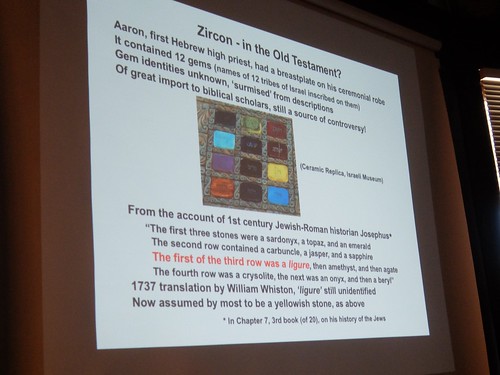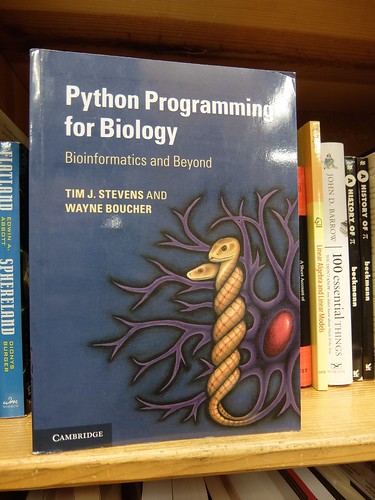I'm somewhat under the gun in my boot camp experience, dashing through a couple Roger Penrose videos, reporting to mathfuture, dashing out to buy a Python-meets-biology book, and so on.
In the midst of all that, I was privileged to drop in on Wanderers, where Steve Mastin was holding forth on zircon, a mineral comprised of the element zirconium, an odd-man-out element with a cation that doesn't crystallize well with the others.
Among these would be Uranium and Thorium, which contribute a lot to zircon's properties, up to making Zirconology, in part about studying chronology.
Zircon's several ways to decay give ways of dating the mineral, a side-benefit of a long-running polonium-related controversy, again with Biblical connotations (see below).
Given earlier civilizations did not use our Periodic Table or understanding of atomic physics, their jargons don't follow ours that closely, and in the case of zircon that's especially true, as in manifests in a wide variety of colors, from vermilion to blue.
In theory it's colorless but in the wild a colorless zircon is a rare find, though some of the colored ones turn colorless with heat treatment, rather commonly applied. Just how a given specimen of zircon will respond to heat treatment is something of a gamble.
Blue is highly prized, though honey-colored is more its trademark. Dick Pugh brought an example, as did Steve but I only had time to take a look at Mr. Pugh's, then was on my errands.
A passage in the Torah about some battle vest, or breast plate, and the twelve stones thereon, probably overlaps our modern definitions. We'd expect to find a specimen of zircon thereon, along with beryl, emerald and some others.
Don't expect me to name all twelve, though if you dig you might find something more like a complete listing in the slides. Steve does a lot of homework to create these talks.
I left around the same time as Jon Bunce, off to Powell's for said biology book. Boot camp continues, with a five mile hike, including steep inclines, bruised ankles be damned.
The impromptu meetup with Dr. DiNucci at Common Ground was apropos, as concurrency concepts, taught through cooking in groups (as with Food Not Bombs) is topical within my code school network. Aside from a Horse Brass half order of Fish 'n Chips, I'm mostly subsisting on Soylent today (version 1.5).
The documentary on Puerto Rico looks interesting (rented from Movie Madness). We don't see many code schools there yet.
Back at my workspace, I made sure VPython is still working. Given the dependency on wxPython, I need to use Python 2.7, and a "Framework" 2.7 at that (to provide access to the main display). So far so good. Things are coming together.
In the midst of all that, I was privileged to drop in on Wanderers, where Steve Mastin was holding forth on zircon, a mineral comprised of the element zirconium, an odd-man-out element with a cation that doesn't crystallize well with the others.
Among these would be Uranium and Thorium, which contribute a lot to zircon's properties, up to making Zirconology, in part about studying chronology.
Zircon's several ways to decay give ways of dating the mineral, a side-benefit of a long-running polonium-related controversy, again with Biblical connotations (see below).
Given earlier civilizations did not use our Periodic Table or understanding of atomic physics, their jargons don't follow ours that closely, and in the case of zircon that's especially true, as in manifests in a wide variety of colors, from vermilion to blue.
In theory it's colorless but in the wild a colorless zircon is a rare find, though some of the colored ones turn colorless with heat treatment, rather commonly applied. Just how a given specimen of zircon will respond to heat treatment is something of a gamble.
Blue is highly prized, though honey-colored is more its trademark. Dick Pugh brought an example, as did Steve but I only had time to take a look at Mr. Pugh's, then was on my errands.
A passage in the Torah about some battle vest, or breast plate, and the twelve stones thereon, probably overlaps our modern definitions. We'd expect to find a specimen of zircon thereon, along with beryl, emerald and some others.
Don't expect me to name all twelve, though if you dig you might find something more like a complete listing in the slides. Steve does a lot of homework to create these talks.
I left around the same time as Jon Bunce, off to Powell's for said biology book. Boot camp continues, with a five mile hike, including steep inclines, bruised ankles be damned.
The impromptu meetup with Dr. DiNucci at Common Ground was apropos, as concurrency concepts, taught through cooking in groups (as with Food Not Bombs) is topical within my code school network. Aside from a Horse Brass half order of Fish 'n Chips, I'm mostly subsisting on Soylent today (version 1.5).
The documentary on Puerto Rico looks interesting (rented from Movie Madness). We don't see many code schools there yet.
Back at my workspace, I made sure VPython is still working. Given the dependency on wxPython, I need to use Python 2.7, and a "Framework" 2.7 at that (to provide access to the main display). So far so good. Things are coming together.


